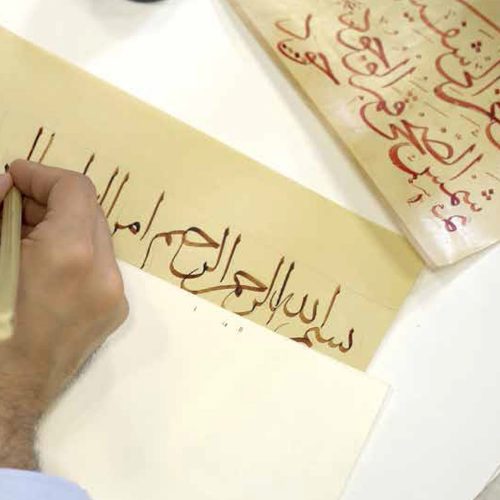The famous mathematician Euclid describes calligraphy as “a spiritual geometry apparent using material instruments”; its simplest description is the embroidery of Arabic letters on art-integrated paper or different grounds. The calligraphy is based on Islam, so the most beautiful examples of it can be seen as the plates on which the Quran verses, hadith-sheriffs, and apothegms (kelam-ı kibar) are scribed. In the whole Islamic world, Ottoman Turks are those who worked on calligraphy and improved it as various schools by providing it with a different attitude. Particularly after the 16th century, calligraphy has got rid of foreign influences, it has become a fundamental school and gained the identity of “Turkish Art”. As in other branches of art, the training of calligraphy in the Islamic world has been carried out within a well-established discipline, adhering to traditional methods and rules, within the framework of a master-apprentice relationship, and by a customized “practice method”.
In a place of worship, the calligraphy is not only seen at engraving, but also at marble, wood, tile, and fabric material like pulpit covers. It was performed in different styles and traditions such as Kufi, Aklam-ı Sitte (Muhakkak, Reyhani, Sulus, Nesih, Tevki, Rikaa), Divani, Rik’a, and Nesta’lik. In the mosques, Teknom Yapı uses anonymous calligraphies of masters of schools such as Ahmed Naksi, Karahisari, Dervis Ali, Mahmud Celaleddin, Seikh Hamdullah, Mehmed Sefik Bey, Ismail Derdi, Seyid Abdullah, Kazasker Mustafa Izzet Efendi, Sultan Ahmed III, Ismail Zuhdu Efendi, Veliyuddin Efendi, Mustafa Rakim, and also collaborates with new calligraphers who have received an authorization from their masters.
In the mosques built by Teknom Yapı, the calligraphy should be on the right stack, at the right place, at the right height, with an appropriate meaning with the architectural unit it is written; it should be read, should give the proper message with connotations, and its compliance with the ornamental program should not be ignored.

